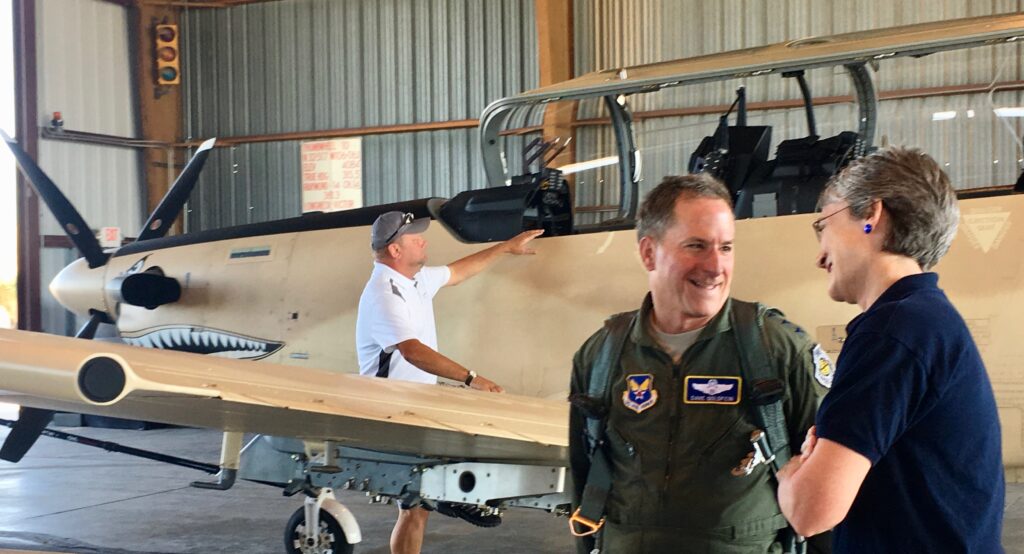Light Attack Competition: Air Force, McCain Tout Acquisition Experiment
Posted on

Air Force Chief of Staff David Goldfein at end of his AT-6 flight.
CORRECTED: TACO GILBERT’S AFFILIATION
HOLLOMAN AFB: It may be hard to believe but the future of the Air Force may depend on three turboprop planes and a $20 million spec-built attack jet.
They are the entries in what the service calls the Light Attack Experiment, a back-to-the-future attempt to rekindle the sort of innovation and fast cycle times that used to mark the development of Air Force fighters and bombers, before the current age when it takes 15 to 20 years to design and buy a new aircraft.
You know it’s important because Air Force Secretary Heather Wilson gave a speech to about 100 top Air Force officials, foreign air force representatives and the media this morning here. Chief of Staff Gen. David Goldfein put on a flight suit and personally flew first an AT-6 up in the morning and then an A-29 in the afternoon.
“This is going to be a great day,” Wilson told the assembly.

Gen. David Goldfein and Air Force Secretary Heather Wilson
Why all this fuss about relatively low-end attack aircraft?
Four aircraft are being run through a gamut of six daytime combat runs and two night runs. At least three of them will land on unpaved runways. What are the planes? The A-29 (made by Embraer) and the AT-6 (made by Textron and based on the Beechcraft T-6) are considered the likeliest planes to be picked should the Air Force buy a Light Attack aircraft. The Scorpion aircraft, developed by Textron using company funds, is also competing alongside the Air Tractor (my personal favorite, mostly because it just looks so damned rugged). The Air Tractor, built by the eponymous company and L-3, was a late entry into the competition and arrived after the other aircraft.
The experiment — or competition or flyoff or whatever you want to call this — has powered ahead since being approved March 8. Using Other Transaction Authority (as Breaking D readers understand) and encouraged to do so by Congress, the service prodded industry to come up with candidates for the Light Attack plane and began testing their capabilities in less than six months. That’s lightning fast by military standards.
Granted, the airframes are not new, but the sensors, avionics and communications capabilities– the guts of the planes — are new. For example, the A-29 flies with Link-16, enabling it to communicate with most advanced US fighters. Its avionics are comparable to those in the F-15 and other advanced aircraft, according to Taco Gilbert of Sierra Nevada Corp., which is partnering with Embraer to turn the Brazilian Super Tucano into the US A-29.

Air Tractor
Sen. John McCain, chair of the Senate Armed Services Committee, has pushed the Air Force to use OTA in pursuit of the Light Attack Aircraft and authorized an impressive $1.2 billion for an estimated 300 aircraft across the five-year defense budget. What makes that especially remarkable is that the Air Force has not committed to buy any aircraft and is, ostensibly, using the competition here to help it decide if it should

A-29 being loaded with weapons
“The light attack experiment at Holloman Air Force Base, New Mexico provides an example for how rapid acquisition and experimentation can help our military procure the needed capabilities more quickly, more efficiently, and more affordably than we have in the past,” McCain said in a statement today. “Our adversaries are modernizing to deploy future capabilities aimed at eroding the U.S. military advantage – and reversing that trend will require a new, innovative approach to acquisition and procurement.”
In the next step in the light attack competition the Air Force will select the most promising pair of planes and run them through a combat experiment early next year, Wilson told reporters here. Industry will also learn a considerable amount from the Air Force about how “to be faster and more dynamic” than they currently are.
Stressing the need for “productive failures,” Wilson said she’s put a photo of the famous Corona spy satellite program on her office wall to remind herself and visitors that you’ve got to take risks and accept failure sometimes to press ahead. The Corona program “failed the first 12 times” before it worked, she noted. But on the fourteenth try its photos proved to the US that there was no “bomber gap” with the Soviet Union. Of course, the Corona program was highly classified at the time and few Americans knew of its failures.
Can Congress, the media and the American public accept failures in weapons systems or will the familiar chorus of the damned ring out each time the services push the envelope in these experiments? Can we afford not to accept failures and continue to be careful and build weapons that take two decades to field?
An earlier version of this article misidentified Taco Gilbert. He works for Sierra Nevada Corporation (SNC), not Embraer, which is SNC’s partner on A-29.
Subscribe to our newsletter
Promotions, new products and sales. Directly to your inbox.
